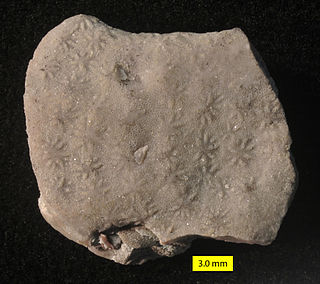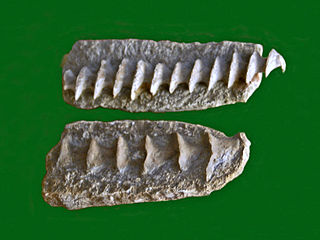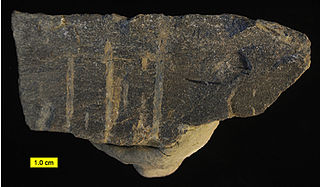Related Research Articles
Stenolaemata are a class of exclusively marine bryozoans. Stenolaemates originated and diversified in the Ordovician, and more than 600 species are still alive today. All extant (living) species are in the order Cyclostomatida, the third-largest order of living bryozoans.
This page features lists of extinct species, organisms that have become extinct, either in the wild or completely disappeared from Earth.
Prehistoric fish are early fish that are known only from fossil records. They are the earliest known vertebrates, and include the first and extinct fish that lived through the Cambrian to the Quaternary. The study of prehistoric fish is called paleoichthyology. A few living forms, such as the coelacanth are also referred to as prehistoric fish, or even living fossils, due to their current rarity and similarity to extinct forms. Fish which have become recently extinct are not usually referred to as prehistoric fish. They were very different from what we have today. They likely were larger and had tougher scales.

Hallopora is an extinct genus of bryozoans of the family Halloporidae, first identified from the Lower Silurian period. They can be found in Ohio, Indiana, and Kentucky of the Midwestern United States, commonly in the Ordovician Kope Formation.

Although the phylogenetic classification of non-vertebrate animals remains a work-in-progress, the following taxonomy attempts to be useful by combining both traditional (old) and new (21st-century) paleozoological terminology.

Constellaria is an extinct genus of bryozoan from the Middle Ordovician to Early Silurian from North America, Asia and Europe. These branching coral-like bryozoans formed bushy colonies 10-15 mm across on the seabed. The fairly thick branches were erect, often compressed in one direction, and covered with distinctive tiny, star-shaped mounds called maculae or monticules. Feeding zoids were located along the rays of the stars. The maculae probably formed "chimneys" for the expulsion of exhalant feeding currents from the surface of a colony, after water had been filtered to obtain food for the organisms.

Archimedes is a genus of bryozoans belonging to the family Fenestellidae. The first use of the term "Archimedes" in relation to this genus was in 1838.
Stigmatella may refer to:

Stigmatella is an extinct genus of bryozoans in the family Heterotrypidae.

Paleontology in Indiana refers to paleontological research occurring within or conducted by people from the U.S. state of Indiana. Indiana's fossil record stretches all the way back to the Precambrian, when the state was inhabited by microbes. More complex organisms came to inhabit the state during the early Paleozoic era. At that time the state was covered by a warm shallow sea that would come to be inhabited by creatures like brachiopods, bryozoans, cephalopods, crinoids, and trilobites. During the Silurian period the state was home to significant reef systems. Indiana became a more terrestrial environment during the Carboniferous, as an expansive river system formed richly vegetated deltas where amphibians lived. There is a gap in the local rock record from the Permian through the Mesozoic. Likewise, little is known about the early to middle Cenozoic era. During the Ice Age however, the state was subject to glacial activity, and home to creatures like short-faced bears, camels, mammoths, and mastodons. After humans came to inhabit the state, Native Americans interpreted the fossil proboscidean remains preserved near Devil's Lake as the bones of water monsters. After the advent of formal scientific investigation one paleontological survey determined that the state was home to nearly 150 different kinds of prehistoric plants.
Fenestrata is an extinct order of bryozoan, dating from the Upper Arenig. Most fenestrate bryozoans formed net-like colonies that water currents flowed through, with autozooecial apertures only on the side of the colony facing into the current.This colony structure was vulnerable to predators, so some fenestrate bryozoans produced skeletal superstructures, likely to strengthen or protect the colony, and others had protective spines surrounding their autozooecial apertures.
Clausotrypa is an extinct genus of prehistoric bryozoans in the family Nikiforovellidae. The species C. elegans is from a Wordian (Permian) marine horizon in the Sijiashan Formation of Northeast China.
Coenites is an extinct genus of prehistoric corals in the family Coenitidae. C dublinensis occurs in the Columbus Limestone, a mapped bedrock unit consisting primarily of fossiliferous limestone, and it occurs in Ohio, Pennsylvania, and Virginia in the United States, and in Ontario, Canada.
Coscinium may refer to:
Coscinium is an extinct genus of prehistoric bryozoans in the family Hexagonellidae. The species C. elegans is from the Paleozoic rocks of the western states and territories.
Coscinopleura is an extinct genus of prehistoric bryozoans in the family Coscinopleuridae. Species are from the Paleocene of Sweden and New Jersey, United States. C. elegans and C. angusta are from the Senonian and Danian of Denmark.
Cystodictya is an extinct genus of prehistoric bryozoans in the extinct family Cystodictyonidae.
Crisia is a genus of bryozoans in the family Crisiidae. Some species are known from the fossil record.
The following are lists of prehistoric animals:
Dyscritella is an extinct genus of trepostome bryozoan that was highly successful in the late Triassic period, re-colonizing high latitudes in the northern hemisphere after the extinction of earlier bryozoan genera. Dyscritella was an "ecological opportunist" and widely distributed, found in every climatic belt.
References
- ↑ The fauna of the phosphate beds of the Park City Formation in Idaho, Wyoming, and Utah. GH Girty, 1910